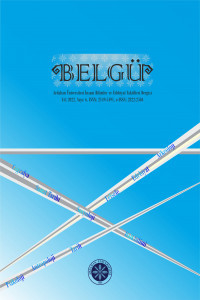İrtiş Nehri İsmi ve Ortaya Çıkışıyla İlgili Efsaneler
İrtiş, Kazakistan’da bulunan en büyük nehirlerden biridir. Moğolistan’da Qara İrtiş adıyla başlayan nehir, Kazakistan sınırlarından geçerek Sibirya’da bulunan Oba nehriyle birleşerek Arktik Okyanusu’na koyar. Bazı bilgilere göre İrtiş ismi, söz konusu nehrin kıyısında yaşayan Ural-Altay ve Türk-Moğol halklarının dil özelliklerine uygun olarak ortaya çıkmıştır. Bir diğer araştırmaya göre, İrtiş kelimesinin kökeni Moğolca ‘İrtsis’ten gelmektedir. İrtiş kelimesi Orhun ve Yenisey yazıtlarında da MÖ 4-5. yy geçtiği bilgileri mevcuttur. Mahmud Kaşgarî da “Dîvânu Lugâti’t-Türk” eserinde bu nehirden bahsetmiş ve İrtiş ismi ile ilgili şu bilgileri aktarır: ‘Artış-Yamak bozkırındaki nehirdir. Çok dallı bu nehir bir göle dökülür. Nehir gerçek anlamıyla ‘Artış suyu veya Ertiş suyu’ olarak adlandırılır. Ayrıca ‘rekabet etmeye çalışmak’ anlamına gelen ‘ertişmek’ fiilinden türetilmiştir”. Bu isim eski Saka, Hun veya Üysin toplumlarının kullandığı dillerinden türetilmiş olma olasılığı vardır. Günümüzde Türkçe İrtiş, Kazakça Ertis, Moğolca Irtsis (aslı Har Erçis Gol), Çince Ertsis şeklindedir. Efsanelere göre, İrtiş Nehri adının ortaya çıkması, Kıpçakların ortaya çıkmasıyla doğrudan bağlantılıdır. Bir diğer anlatımda, Nogay Şehzadesinin karısı nehrin yanına gelen yabancı erkeklere, ‘Er, tüs!’ (Yiğit atından in!) diyerek seslendiğinden dolayı bu nehre ‘Ertis’ adı verildiği söylenir. En yaygın olan efsanede ise İmi, İmek, Tatar, Bayander, Kıpçak, Lanikaz ve Aclad isimli yedi gencin Türk boylarını oluşturup İrtiş’in kıyılarına yerleştiğidir. Bir diğer efsaneye göre İrtiş kelimesi Kerey ve Nayman kabilelerinin birbirlerinden ayrılmasıyla ilgilidir. Bu dönemlerde iki kardeş kabile ‘Ükili Xat’ (pühü kuşu tüyü ile korunarak kutsanmış mektup) aracılığıyla düşmanın yaklaştığından haberdar olmasıdır. Mektuba "Ükili Xat"; ulağa ise Ertiş (Er-tis, yetiş); düşmanların saldırısına engel olan nehre de zamanla Ertis nehri denilmeye başlamıştır. Gördüğümüz gibi ‘İrtiş’le ilgili farklı görüşler vardır. Hatta Kazak sözlü edebiyatında da ‘Ertis’ nehrinin adı sıkça geçmektedir. Çalışmada Kazaklar için hayat kaynağı olan İrtiş nehrinin etimolojisi, nehirle ilgili mitolojik efsanelerle ilgili bilgiler verilmiştir.
The Name Of The Irtysh River And The Legend Of Its Emergence
The length of the Irtysh is 4248 m. It is the longest river in Kazakhstan. The river originates in Mongolia. Irtysh, passes through the territory of Kazakhstan. It joins the Oba River in Siberia and flows into the Arctic Ocean. The name Irtysh appeared according to the linguistic characteristics of the Ural-Altaic and Turko-Mongol peoples living on the banks of the great river. According to the origin of the Irtysh toponym derives from the Mongolian 'Irtsis'. Moreover, the Irtysh toponymy is also mentioned in the Orkhon-Yenisey inscriptions (4th-5th centuries BC). Mahmud Kasgarî mentioned the river in his ‘Dîvânu Lugâti’t-Türk’ (Dictionary of Turkish Language) and he mentions the name Irtysh as follows: 'Artis-Yamak is the river in the steppe. This very branched river empties into a lake. The river is literally called 'Rise water - Ertiş water'. Also said that the name Irtish was derived from the infinitive "ertişmek", which means "trying to compete". This name is not derived from pure Turkish vocabulary, it is possible that it is derived from the languages used by the ancient Saka, Hun or Üysin societies. Today, it is Turkish Ertiş, Kazakh Ertis, Mongolian Irtsis (originally Har Erçis Gol), Chinese Ertsis. According to legends, the appearance of the name of the Irtysh River is directly related with the emergence of the Kipchaks. In another narration, it is said that this river was called 'Ertis' because the wife of the Nogai bey called out to the foreign men who came to the river by saying, 'Er, tüs!' (Get off your valiant horse!). The most interesting thing in the legends is that seven young people named Imi, İmek, Tatar, Bayander, Kipchak, Lanikaz and Aclad formed Turkish tribes and settled on the shores of Irtish. As we have seen, there are different views on the 'Irtysh'. According to another legend, the irtysh toponymy is related to the separation of the Kerey-Nayman tribes from each other. During this period, two brother tribes were aware of the approach of the enemy through the 'Ukili Xat' (letter protected by a feather bird). The letter was called "Ukili Xat", the postman was called Ertiş (Er-tis), and the river, which represented an obstacle that slowed down the enemies on the way, started to be called the Ertiş river over time. As we have seen, there are different views on the 'Irtysh'. In fact, the name of the river "Ertiş" is frequently mentioned in Kazakh Oral Literature, especially in love epics. This article examines the source of life of Kazakhs, the emergence of the toponym of the river "Irtysh" against the background of mythological legends about "Irtysh".
___
- REFERANS 1 Abdirahmanov A. 1975. Toponimka jane Etimologiya (Toponimi ve Etimoloji), Almatı: Yayınevi yok.
- REFERANS 2. Ahmetjanova F., Alimhan A. 2000. Qazaq Şığısınıñ Jer-Su Atavları (Kazakistan’ın Doğusundaki Yer-Su Adları), Oskemen: ŞQTU Yayıncılığı.
- REFERANS 3. Biyarov B. 2012. Jer-Su Attarınıñ Sözjasamdıq Ülgileri (Yer-Su Adlarının Oluşum Kalıpları), Almatı: Memlekettik Tildi Damıtuw İnstitutı Yayıncılığı.
- REFERANS 4. İmanberdiyeva S. 2004. Qala Onomastikasının Keybir Mäseleleri (Şehir Onomastiğinin Bazı Sorunları), Almatı: Arqas Yayıncılığı.
- REFERANS 5. İmanberdiyeva S. 2010. Tarihi Onomastikalıq Keñistik (X-XIV yy. Türki Jazba Eskertkişteri Negizinde) (Tarihsel Onomastik Genişlik), Almatı: Firma Ornak Yayıncılığı.
- REFERANS 6. İteğulova S. 2016. Onomastika Jäne Körneki Aqparat: Mindetter men Usınıstar (Onomastik ve Görsel Bilgi: Görevler ve Öneriler), Astana: Yayınevi yok.
- REFERANS 7. İteğulova S., Jarılğasın D. 2017. Şığıs Qazaqstan Oblısınıñ Tarihi Jäne Qazirgi Atavları (Doğu Kazakistan Bölgesinin Tarihi ve Şimdiki Onomastik İsimleri), Astana: Yayınevi Yok.
- REFERANS 8. Janaydarov O. K. 2014. Qazaq Jeriniñ 100 Añızı (Kazak Topraklarının 100 Efsanesi), Almatı: Soraba Yayıncılığı.
- REFERANS 9. Januzak T. 2006. Qazaq Onomastikası (Kazak Onomastiği), C. I, Astana: ‘1C-Servis’ Yayıncılığı.
REFERANS10. Januzak T. 2007. Dağ-Tepe Efsaneleri, Aziya Tranzit, No 7/8, ss. 43-49.
